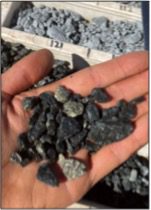Artemis Resources (ASX: ARV) believes it may have found a structural repeat of the Carlow host-sequence after positive assay results at its 100 per cent owned Carlow Gold and Copper Project in the West Pilbara region of Western Australia.
Drilling at the Chapman Prospect, approximately 250 metres from the historic Good Luck workings, was completed as part of a circa 14,000 metre RC programme, which wound up in September 2021.
Two wide-spaced RC holes, GLC007 and GLC008 targeting VTEM anomalies were drilled at the Chapman Prospect. Hole GLC007 was successful and intersected:
- 10m @ 3.40% Cu, 1.75g/t Au and 24.65g/t Ag from 116m, including; 5m @ 6.23% Cu, 3.01g/t Au, 45.32g/t Ag from 117.00m; and
- 3m @ 1.73% Cu, 1.04g/t Au, 12.67g/t Ag from 138m
“To hit thick, shallow, high-grade Copper-Gold-Silver mineralisation in one of two ‘wildcat’ holes at Chapman, to the Southeast of old workings at Good Luck, is highly encouraging,” Artemis executive director. Alastair Clayton, said.
“We have long suspected that structural repeats of the Carlow host sequence were possible and even likely. Whilst still early days, these drill results combined with ultra-fine geochemistry and geophysics add significant weight to our team’s belief in just that.”
At Chapman, a total of 1,836 samples from eight holes were sent for analysis. These holes targeted a series of Versatile Time Domain Electromagnetic (VTEM) plate anomalies, with all plates dipping shallowly to the NW with some holes orientated to drill beneath old workings that seem to indicate some structure that trended to the ENE, based on the orientation of the shafts and trenches.
A majority of holes intersected sulphides of various percentages that coincided with the VTEM anomalies, with the most spectacular interval occurring in hole GLC007.
GLC007 was targeting a VTEM plate (Figure 5) that was isolated and seemed ‘off-trend’. Significant sulphides (up to 15%) were intersected, comprising predominately of pyrite and pyrrhotite.
In addition to the drilling, 52 Ultrafine Fraction (UFF) soils were taken on a 200 x 50m grid to assist in identifying the structures that may host mineralisation.
Results are still pending for the infill soil sampling programme, completed in November.
Mr Clayton said further work is planned in 2022 to follow up on these great results.
For further information please visit: https://artemisresources.com.au/











